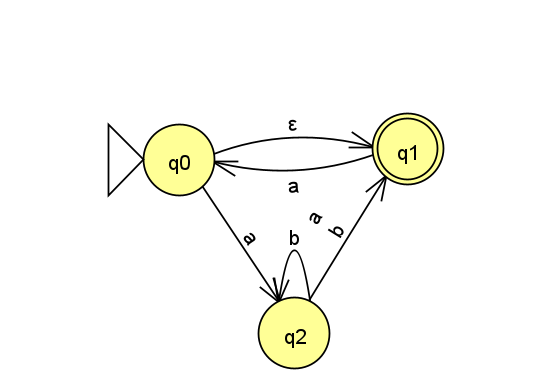Homework 2
Last updated: Wed, 9 Feb 2022 20:09:28 -0500
Out: Mon Feb 07, 00:00 EST Due: Sun Feb 13, 23:59 EST
This assignment explores nondeterministic finite automata (NFAs).
Homework Problems
NFA Formal Description (5 + 5 = 10 points)
Exending the definition of "REACHABLE" (5 points)
DFA->NFA (5 points)
Another Closed Operation on Regular Language (5 points)
README (1 point)
Total: 26 points
Submitting
Submit your solution to this assignment in Gradescope hw2. Please assign each page to the correct problem and make sure your solutions are legible.
A submission must also include a README containing the required information.
1 NFA Formal Description
Recall that a NFA’s formal description has five components, e.g. N = (Q,\Sigma,\delta,q_0,F), where \delta:Q\times\Sigma_\varepsilon\rightarrow\mathcal{P}(Q) is the transition function mapping a state and input symbol (or no symbol, in the case of an empty transition) to a set of states.
Come up with a formal description for the following NFA:

- Come up with the result of the following computations and say whether it represents an accepting computation:
\hat{\delta}(q0,\varepsilon)
\hat{\delta}(q0,\texttt{a})
\hat{\delta}(q1,\texttt{ba})
\hat{\delta}(q2,\texttt{abb})
\hat{\delta}(q0,\texttt{abb})
2 Exending the definition of "REACHABLE"
Define \varepsilon\textrm{-{\footnotesize REACHABLE}}_{qs}, which is like the \varepsilon\textrm{-{\footnotesize REACHABLE}} definition from class, except its input is a set of states.
Hint 1: You are allowed to call the \varepsilon\textrm{-{\footnotesize REACHABLE}} for single states that we defined in class in your definition of \varepsilon\textrm{-{\footnotesize REACHABLE}}_{qs}.
Hint 2: The definition of \varepsilon\textrm{-{\footnotesize REACHABLE}}_{qs} is very straightforward. In particular, it does not need to be a recursive definition.
3 DFA->NFA
In class we showed how to convert an NFA into an an equivalent DFA. Now show how to do the opposite: convert a DFA to an equivalent NFA.
More specifically, come up with a procedure \texttt{DFA}\!\!\rightarrow\!\!\texttt{NFA} that converts DFAs to equivalent NFAs. In other words, given some DFA M = (Q,\Sigma,\delta,q_0,F) that satisfies the formal definition of DFAs from class, \texttt{DFA}\!\!\rightarrow\!\!\texttt{NFA}(M) should produce some NFA N = (Q^\prime,\Sigma,\delta^\prime,q^\prime_0,F^\prime) that satisfies the formal definition of NFAs and accepts the same language as M.
4 Another Closed Operation on Regular Language
Define the following operation, called \mathrm{SUB}, on languages:
\mathrm{SUB}(A,B)=\{w\mid w\in A\textrm{ and }w \notin B\}
Prove that \mathrm{SUB} is closed for regular languages.